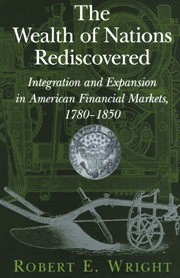 The Wealth of Nations Rediscovered
The Wealth of Nations Rediscovered Book contents
- Frontmatter
- Contents
- List of Tables
- Acknowledgments
- List of Abbreviations
- The Wealth of Nations Rediscovered
- 1 Introduction: The Wealth of Nations and National Wealth
- 2 The International and Colonial Background of America's Financial Revolution
- 3 Banks, Securities Markets, and the Reduction of Asymmetric Information
- 4 The Financial Sector and the Reduction of Lending-Related Costs and Risks
- 5 Evidence of Capital Market Integration, 1800–1850
- 6 Expansion of the Securities Services Sector, 1790–1850
- 7 The Freest of the Free: Regulation of the Financial Sector
- 8 Finance-Directed Economic Development
- 9 Conclusion
- References
- Index
5 - Evidence of Capital Market Integration, 1800–1850
Published online by Cambridge University Press: 16 January 2010
- Frontmatter
- Contents
- List of Tables
- Acknowledgments
- List of Abbreviations
- The Wealth of Nations Rediscovered
- 1 Introduction: The Wealth of Nations and National Wealth
- 2 The International and Colonial Background of America's Financial Revolution
- 3 Banks, Securities Markets, and the Reduction of Asymmetric Information
- 4 The Financial Sector and the Reduction of Lending-Related Costs and Risks
- 5 Evidence of Capital Market Integration, 1800–1850
- 6 Expansion of the Securities Services Sector, 1790–1850
- 7 The Freest of the Free: Regulation of the Financial Sector
- 8 Finance-Directed Economic Development
- 9 Conclusion
- References
- Index
Summary
Price and securities ownership data show that securities markets rapidly integrated; prices for identical or comparable securities fluctuated in unison and moved closer together over time, and ownership of securities was local, regional, national, and even international. Price integration occurred quickly in the 1790s but suffered minor setbacks in some later periods. In all periods studied, however, the markets behaved rationally, in accordance with the Theory of Portfolio Choice. The markets were also transactionally efficient, as measured by bid-ask spreads; though higher than spreads today, the bid-ask spreads of early U.S. market makers were surprisingly small. Also, as an analysis of stock ownership patterns in antebellum Maine will show, ownership of capital market instruments was geographically integrated. Other scholars have come to similar conclusions using different data and different analyses.
It has taken scholars so long to recognize the integration and efficiency of early national and antebellum capital markets because postbellum capital markets were not very good. Because scholars often assumed that development was linear, it was easy, a priori, to dismiss antebellum capital markets as inefficient. Development, however, was not linear, at least not when it came to financial markets. The death of a few million men, the destruction or emancipation of millions of dollars worth of property, the implementation of new banking and currency systems, and the near destruction of the Constitution were the causes of postbellum capital market inefficiencies, not endemic financial backwardness.
- Type
- Chapter
- Information
- The Wealth of Nations RediscoveredIntegration and Expansion in American Financial Markets, 1780–1850, pp. 82 - 122Publisher: Cambridge University PressPrint publication year: 2002


